
Dr Sonali Mehta leads us through the treatment of severe maxillary and mandibular crowding using In-Line clear aligners.
People of all ages want a beautiful, natural smile as well as healthy teeth and gums. An increasing number of adult patients with anterior spacing or crowding are willing to undergo orthodontic treatment in order to achieve this. However, they often want the appliance to be as inconspicuous and comfortable to wear as possible. In many cases the patient can be treated successfully with aligner therapy. In this case the anterior crowding was treated with In-Line aligners produced in Germany by Rasteder Orthodontic Laboratory.
Initial Situation
The patient wanted to resolve her severe maxillary and mandibular crowding in order to improve both the appearance of her smile and also her dental hygiene. She expressed a desire to have the mal-alignment corrected with a therapy which should be as invisible as possible. The severity of the crowding was immediately apparent from a frontal view (Fig. 1). However, the mal-alignment is even more clearly seen when viewed from the side. (Fig. 2) UR2 and UL2 were noticeably labial compared to the neighbouring teeth. The lower anterior arch was severely crowded with the canines situated labially to the other anterior teeth

Figure 1 Initial situation frontal view
.JPG)
Figure 2 Initial situation lateral view
As a part of the diagnostics, a study model and OPG were produced. Clinical examination showed that the patient’s teeth and gums were otherwise healthy with no problems relevant to orthodontic treatment.
Treatment Decision
In addition to treatment with In-Line, other treatment options were discussed with the patient. The dentist informed the patient that a more comprehensive treatment result can often be achieved by using fixed appliances. However, even braces made of tooth coloured ceramics were rejected by the patient on both aesthetic and comfort grounds. The patient was shown a sample of an In-Line aligner. This solution met her need for comfort; the aligners are very comfortable as they are made from a patented twin layer plastic, they affect the patient's speech only initially and are visually barely noticeable. In-Line’s laboratory charges are also significantly lower than some competitive brands, which brings the treatment within the reach of a wider range of patients.
Treatment Planning
A quotation with treatment recommendations and a 3D digital set-up / preview was requested from In-Line. The 3D preview includes 7 images of the final situation, allowing the patient to see how her teeth will appear post treatment from all angles. (Fig 3,4,5, 6 and 7)
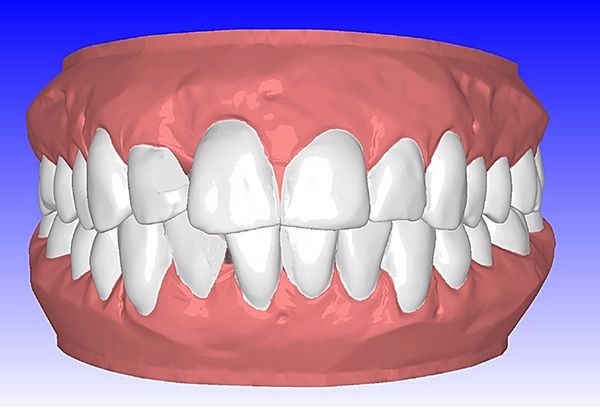
Figure 3 Preview (anterior)
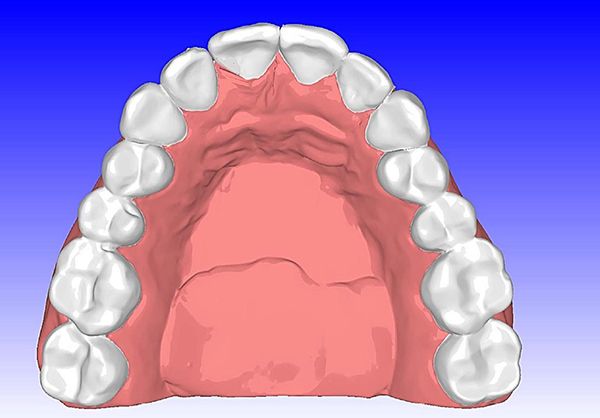
Figure 4 Preview (upper form occlusion)
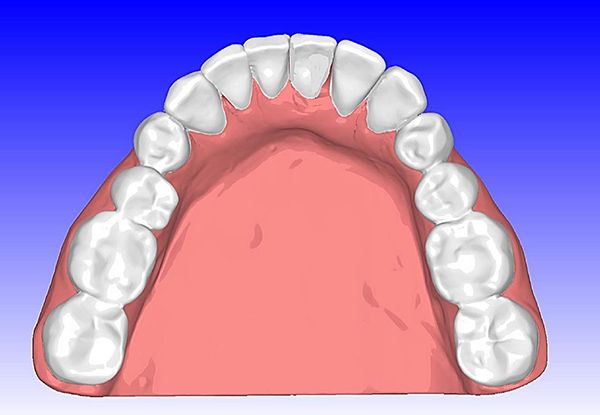
Figure 5 Preview (lower form occlusion)
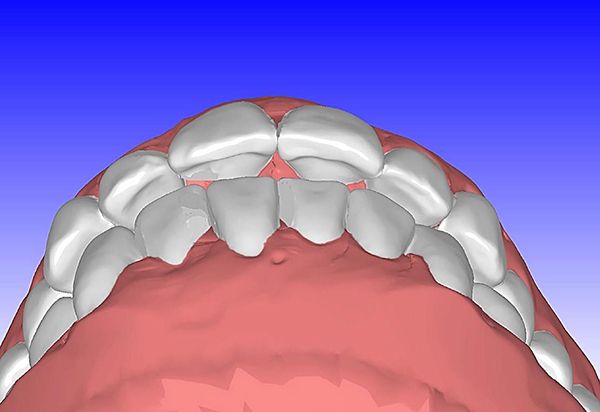
Figure 6 Preview (anterior occlusion)
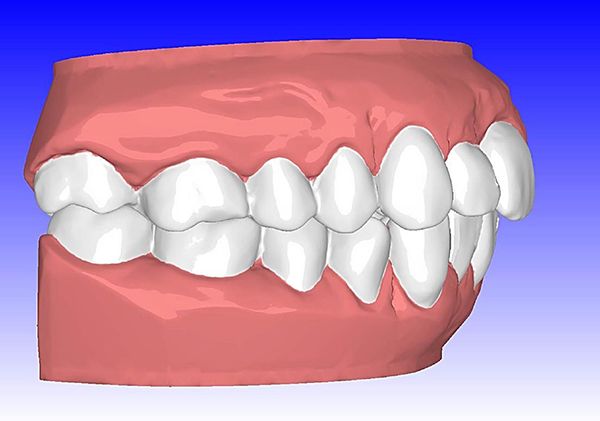
Figure 7 Preview (lateral)
The treatment proposal prescribed 7 aligners for the upper arch and 9 aligners for the lower arch to be worn for 4-6 weeks each. Due to the advanced technology of the In-Line system, each aligner can effect a movement of up to 0.6mm, which is much greater than other types of clear aligners, this also results in shorter treatment times.
The treatment recommendations proposed slight inter-proximal in the upper and lower arches.
Treatment Progress
The patient was given new aligners successively at individual check-up appointments, at intervals of approximately four weeks. Inter-proximal enamel reduction was carried out incrementally over the first 4 to 5 splint fittings, until the enamel had been reduced by the specified amount. The patient wore the aligners for the recommended time of at least 20 hours a day and the treatment goal was reached in around 12 months including a short period of refinement. (Fig 8, 9, 10 and 11)
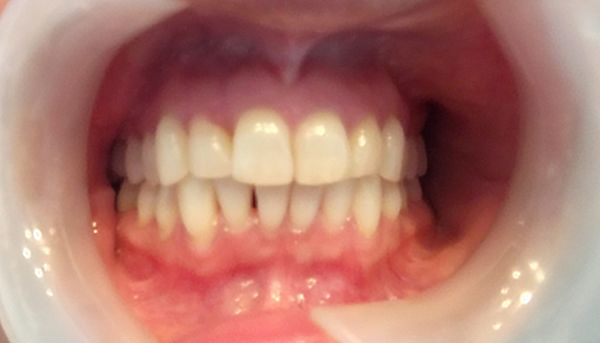
Figure 8 Anterior view after treatment (in occlusion)
.jpg)
Fig 9 Anterior view after treatment (in protrusion)
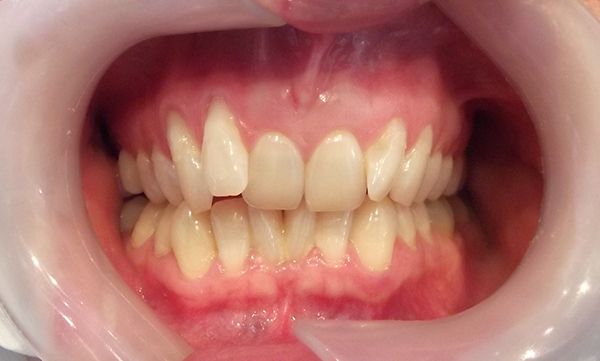
Figure 10 Anterior view before treatment
.jpg)
Figure 11 Anterior view after treatment
A comparison of the post treatment photographs and the preview pictures (sent by In-Line pre-treatment) shows that the treatment goal had been achieved almost perfectly. (Fig 12 and 13)
.jpg)
Figure 12 Anterior preview picture


Figure 13 Anterior view post treatment.
Retention
Long term retention is crucial following adult orthodontic treatment in order to avoid the risk of potential relapse. A long term retention package is included with all In-Line aligner treatments: This consists of either two durable removable night time retainers per arch or a 3-3 fixed/bonder wire retainer with a durable removable retainer fitting over the top. In this case the patient chose the 3–3 bonded wire retainer package as her chosen method of long term retention. (see figure14)
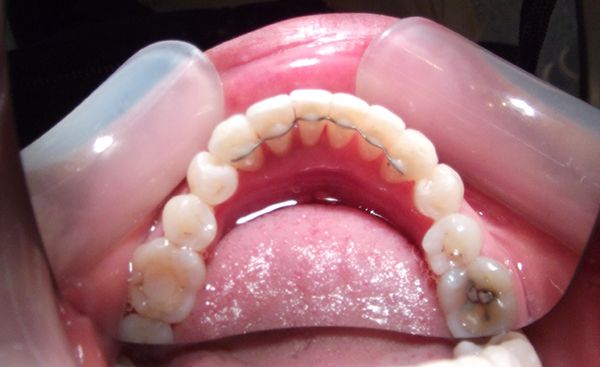
Figure 14 Fixed / bonded retainer
Sonali Mehta BDS (Mang), MSc Paedo (Aus), LDS RCS(Eng)
Sonali Mehta qualified in Mangalore in 1992, further developed her surgical and clinical skills treating children with cleft lip and palate as part of an MSc in Adelaide, and tutoring undergraduates during her LDS RCS at Guys Hospital in 1999. She worked as an associate for a few years before taking over ‘The John Wolffe Dental Practice’ and ‘Smile Matters’, both in late 2007 in North London. She has used the In-line system since 2011 and is very confident of the technical backup and case selection criteria to achieve a successful outcome each time.
